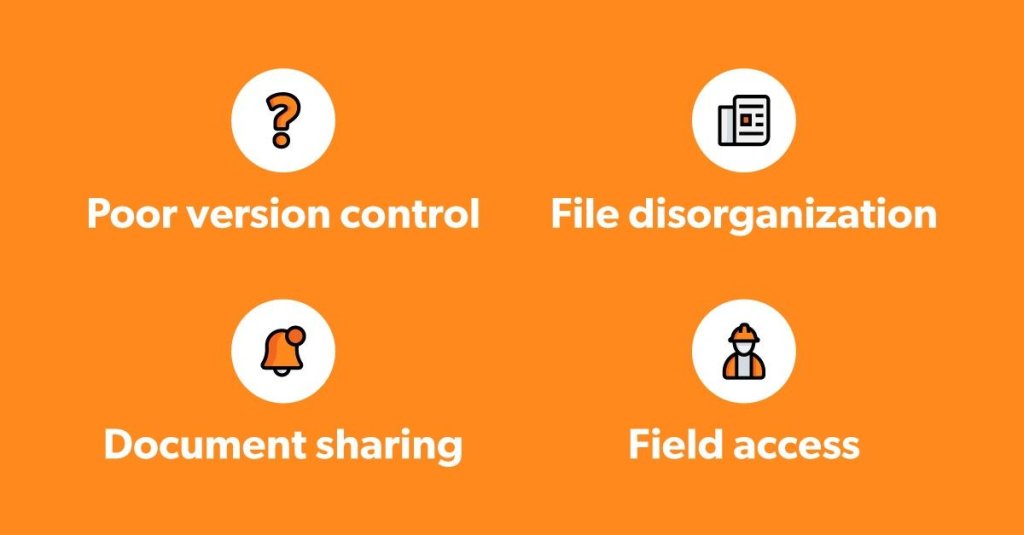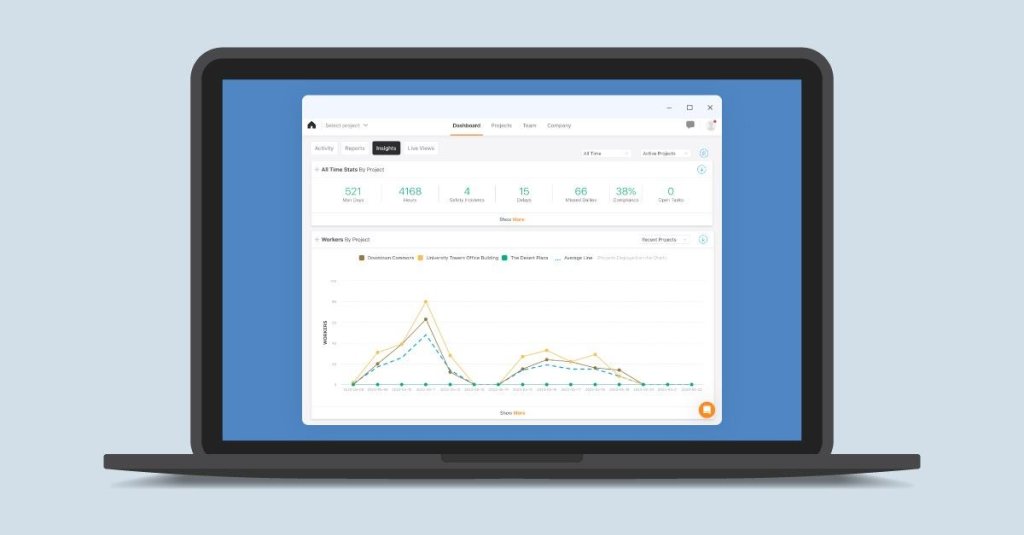From reports and time cards to safety and quality checklists, construction companies generate many different types of documents on a daily basis. Establishing a process to organize project documentation ensures no important data or resources are lost.
What is construction document management?
In construction, document management is the process a business uses to store, organize, and access contracts, permits, daily reports, blueprints, and other types of documents essential to a construction project.
Document management may involve both physical and digital systems. Project managers, superintendents, and other stakeholders utilize various tools and strategies to maintain documentation and keep data secure.
Document management is the process used to store, organize, and access all the documents essential to a construction project.
Why is construction document management important?
Construction document management is important because, with an effective process, construction companies can quickly access information that helps them accurately monitor performance, make informed decisions, and protect themselves from disputes and litigation.
Good document management practices reduce risks and improve efficiency.
Recommended Read
What is Construction Litigation?
Learn about common legal issues in the industry and how to avoid them.
Common types of construction documents
The most common types of construction documents are:
Bid proposals
Blueprints
Daily reports
Production tracking
Time cards
Permits
Material tracking
Safety and quality checklists
Contracts
Change orders
Stakeholders need to keep these resources organized so they can quickly locate specific documents whenever they need to review or reference them.
Recommended Read
Construction Project Documentation Checklist
Read more about common types of documentation and how they fit into the construction process.
Challenges of construction document management

Because contractors manage a high volume of documents throughout the course of a project, choosing the right construction document management system is a difficult decision. The main challenges of construction document management include:
Poor version control
File disorganization
Document sharing
Field access
Poor version control
When you're documenting a complex process or task that requires contributions from multiple people, it's easy to lose track of who changed what and when those changes were made.
Accurately tracking all the updates to a single document is complicated, but because specificity and accountability are critical when you're assessing productivity, managing safety or quality concerns, and resolving disputes, you need a reliable way to do so.
Your document management system should include some form of version control. It should allow seamless collaboration for your crew, but give managers an easy way to view a document's history and make sure they're looking at the final product.
File disorganization
It's frustrating to waste valuable work hours searching through a disorganized file system when you need to locate a report or checklist. But, when your projects are complex, it's also not easy to stay consistent with the way you save information. Part of document management is establishing a standardized structure for organizing project documentation.
Document sharing
Good communication between the field and office is essential. Document management addresses how documentation is shared.
Both the needs of your field crew and offsite staff are important. Neither should feel like they're wasting valuable work hours on printing documents, composing text messages, writing emails, and uploading or downloading attachments.
Make sure your document management system makes document sharing more streamlined for all members of your team.
Make sure your document management system makes document sharing more streamlined for all members of your team.
Field access
It's usually easy enough to access a computer or file cabinet in the office, but what happens when your superintendent or foreman wants to check a previous report in the field?
Consider how your document management system will address field access.
Tips for improving your construction document management
If you're looking to improve document management at your construction company, follow these steps:
Review your current system
Streamline workflows
Centralize data
Standardize file organization
Automate file sharing
Utilize document management software
1. Review your current system
Take the time to review your current document management process. Make a list of all the documentation your business uses and briefly outline how each type of document is created, shared, and stored.
Seek feedback from the employees directly involved to see what's currently working and identify their pain points. Capture all the common problems you and your employees experience when trying to find files or trace issues back to the source.
2. Streamline workflows
Create new workflows to address the issues you identified during your review.
For example, does your accounting team get overwhelmed trying to organize time cards? Maybe it's time to create a standardized template. Do you require jobsite photos for quality inspections, but your crew thinks it takes too much time to upload and attach them to email? Find a way to allow them to share photos automatically with the related checklist or report.
Remember that your new document management workflows should help you improve the way you collect and maintain data without adding unnecessary stress to the workday. Otherwise, your team may struggle to adopt any changes.
Recommended Read
Using Data to Streamline Construction Project Management
Use historical data to build better bids and make more informed decisions about timelines, budgets, hiring, and more.
3. Centralize data
A daily report is very different from a time card, but the same employees may need to use data from both. Your document management system should keep project data in the same place whenever possible.
Even though different types of documents may be created and submitted in different ways, consider using a system that helps you organize and store related documentation together. That way the info you need is never far, regardless of format.
4. Standardize your storage system
Take your list of documents and determine the ideal structure of your storage system. How should you separate and store documents based on what's working-and not working-now?
Whether you're using a digital or physical storage system, typically each separate project will have its own main folder or bucket where all the documentation related to that project will reside. However, the organization of files within that project folder may vary depending on how your business works.
For example, you may organize documents by type, by date, or crew responsible. You may have a separate folder for each phase of the project, or you may choose to group files based on importance. Develop a system that works for you, and make sure that it stays consistent across your entire organization.
If you're using digital documents, you also should determine a standardized naming structure. This will make finding specific documents easier when using a search function.
5. Utilize document management software
Document management software can help construction companies with each of the steps outlined above. Digital documents are much easier to manage and can be tracked more closely than physical copies. If you haven't yet transitioned from pen and paper to digital, chances are you're wasting time and money on manual data entry and repetitive tasks that could be automated.
There are modern tools available to help construction businesses maximize efficiency in nearly all their workflows, and document management is no exception.
Construction document management software

Implementing construction document management software is an easy way to improve your document management process.
Make data capture easy
Going digital means creating daily reports, completing time cards, and filling out checklists takes less time and effort in the field. Create a template, assign it, and your crew can use their mobile devices to quickly capture data and submit documentation with the click of a button.
It's also easier for project managers to combine and analyze field data when it's digitally standardized.
Get all your info in one place
With construction document management software, you can store all your valid project documents in the same convenient location. You can organize your files in the way that makes the most sense, using a search function to locate them instead of having to rely on memory.
Your team will always know where to find the information they need.
Share files instantly
Through cloud storage, a digital document management system makes file sharing easy. Instead of composing emails or text messages, your crew will submit documentation and stakeholders can be notified instantly.
They can access documents in real time, and they'll have a digital record of version history.
Integrate document management with your tech stack
If you're using pen and paper and you need to share data digitally, you'll have to manually transfer it. With document management software, you can share data with your accounting or project management software automatically.
With integrated document management you significantly reduce the time it takes to process payroll or analyze project progress.
In conclusion...
Document management is an important part of successful project management in construction. There are many different types of documents that construction companies use to plan projects, monitor performance, and resolve disputes or legal issues.
Setting up a standardized document management system helps businesses better utilize the information they've collected throughout the construction process. With best practices and the help of construction document management software, you can more effectively maintain documentation and quickly find key points of information whenever needed.
Keep all your important project data in one place
Raken's easy-to-use web and mobile app helps your crew collect detailed data from the field and share daily reports, time cards, and checklists with the office in real time.
